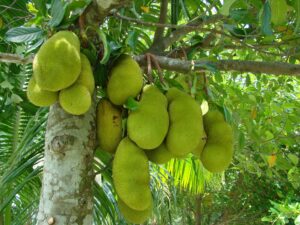B.N. – Artocarpus heterophyllus
Family – Moraceae
Ch. No. – 2n = 56 (Auto tetraploid)
Origin – India
Fruit type – Sorosis (Multiple fruit)
Edible part – Bracts/Perianth
Watch Lecture Video
Important Point
- Fruiting occurs terminally on the current season’s growth.
- Cauliflorus bearing habit.
- Vivipary condition is present in jackfruit.
- Seeds are sown immediately after extraction.
- Soak the seeds in 25ppm NAA for 24 hours. This improves their germination and seedling growth.
- It contains 20% carbohydrates.
- They are considered a ‘good source of pectin’.
- It is the largest fruit grown in India.
- They cannot tolerate cold and frost.
- Maximum production takes place in Assam.
Varieties
- Gulabi
- Champ

Jack Fruit - Hazari
- Rudrakshi jack
- Singapore or Ceylon Jack.
- Muttam varikka
- Monkey Jack.
Climate
- Jackfruit is a tropical plant that thrives well in hot and humid climates.
- Grown-up to an altitude of 1500 m
- Sensitive to cold and frost.
Soil
- Deep, rich, well-drained alluvial soil.
Propagation
- Usually propagated by air layering.
- The suitable time for air layering is from July to September.
Planting
- Pits of size 10m3 are dug 2 weeks before planting to allow exposure to the sun to destroy soil-borne pathogens.
- The planting distance is kept at 10 x 10 m.
- The ideal planting time is mid-June to late August but with irrigation facilities, it can be extended till November.
Manure and fertilizers
- 210:160:1000 g/tree NPK and 20-30 kg FYM/tree (full bearing trees).
- Apply the full amount of FYM + P2O5 + K2O and half of N at the end of January, and the remaining half of Nitrogen from February to March.
Irrigation
Jackfruit is cultivated in India as a rain-fed crop. Irrigation is required in arid and semi-arid regions where annual rainfall is less.
Interculture and Intercropping
The orchard floor and tree basins should be kept free from weeds by frequent shallow hoeing, cultivation of some vegetables like radish, brinjal, chili, etc. can generate some income.
Flowering and fruit set
- Flowering starts from late November to December and continues till February.
- It is a monoecious tree. The inflorescence is a spike.
- Male inflorescences arise from both the primary or secondary branches and the rootstock, while the female spike emerges from the rootstock.
- The ratio of male to female flowers in small trees is very high.
Harvesting
- A dull, hollow sound is produced when the fruit is tapped with a finger.
- The last leaf of the stalk turns yellow.
- The spines of the fruit are well developed and distant.
- A fragrant odor develops.
- The tender jackfruit, which is used for cooking (culinary purposes), is plucked before the seeds harden.
Yield
- 250 to 300 fruits per year.
- The weight of individual fruits varies from less than a kilogram to 15-20 kilograms.
Pests
-
Shoot and trunk borer (Diaphania cacsalis)
The caterpillars burrow into branches, buds, and fruits.
Control
Spraying of carbaryl @ 4 gm /liter in flowering season.
-
Fruit borer (Glyphodes caesalis)
The reddish-brown larvae bore into the fruit and destroy them.
Control
Spraying of carbaryl @ 4 gm /liter in flowering season.
Disease
-
Pink disease (Botrybasidium salmonicolor)
Young woody branches show die-back symptoms and pink encrustation is seen on the lower side of the leaves.
Control
- The affected parts should be cut out along with some healthy tissue.
- The cut ends should be covered with Bordeaux paste.
-
Blossom and fruit blight (Botrytis cinerea & Rhizopus stolonifer)
Attack of the disease causes the premature drop of young jack fruit.
Control
- Spray benomyl (0.04%)
-
Rhizopus rot (Rhizopus artocarpi)
The pathogen usually infects the male inflorescence and small fruits. The rot starts near the stalk end.
Control
- Spray Dithane M-45 @ 0.2% and Bavistin @ 0.05% three time at 14 days intervals.
